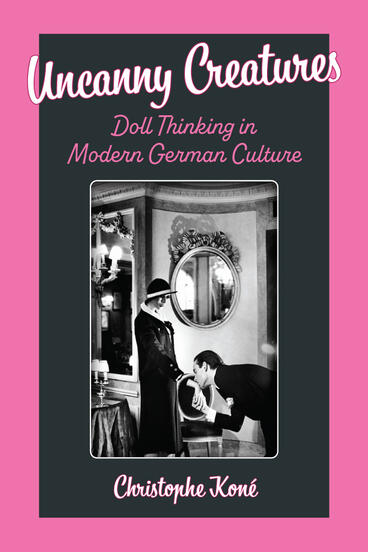Uncanny Creatures
Doll Thinking in Modern German Culture
How dolls have fascinated writers, thinkers, and artists alike in Modern German culture
Description
Germany held a monopoly on the manufacture and export of bisque toy dolls in Europe before WWI. Yet, dolls’ omnipresence in the material, visual, and literary culture of the modern German-speaking world has so far not been properly addressed. In demonstrating this cultural affinity for dolls, Christophe Koné draws upon a range of stories and seminal essays on dolls, as well as toys, sculptures, paintings, and photographs. He examines how E.T.A. Hoffmann’s romantic tale The Sandman (1815) has been a major source of inspiration for German-speaking doll makers because of how it centers imagination and inventiveness. Using Hoffmann’s tale as an early example of an amalgam between doll thinking and making in German culture, Koné shows how it initiated a genealogy of doll thinkers (Freud & Jentsch), writers (Rilke), painters (Kokoschka), photographers (Bellmer), and makers (Pritzel).
Uncanny Creatures then explores how this unusual interest in human-like figures continues a long tradition of thought devoted to conceptualizing “things,” from Immanuel Kant’s theory of the thing-in-itself to Martin Heidegger’s lecture on the thing, and Eduard Mörike or Rainer Maria Rilke’s thing-poems. Because dolls occupy a liminal space—not quite things and more than mere objects—they appear as uncanny creatures which have held a fascination for writers, thinkers, and artists alike. Uncanny Creatures moves past the Freudian discourse of fetishism to propose a new reading of doll artifacts in German culture centered on their ability to evoke a feeling of uncertainty and unsettlement in the viewer.
Christophe Koné is Associate Professor of German at Williams College and Director of the Oakley Center for Humanities and Social Sciences.
Reviews
“Uncanny Creatures contributes a new and novel theory of dolls and their relationship to the concept of the uncanny. It also contributes to the ongoing/emerging scholarship on gender and queer studies to the fields of German studies and art history.”
- Nathan Timpano, University of Miami
“Uncanny Creatures tells a story of “doll thinking” that places the emphasis on modernist creativity, rather than on the familiar Freudian reading of E.T.A. Hoffmann’s automaton. Artists and poets such as Rilke, Pritzel, Kokoschka, and Bellmer, in Koné’s compelling analysis, approach their doll creations with an effective combination of fascination, repulsion, and even comedy.”
- Catriona Macleod, University of Chicago
—Catriona Macleod, University of Chicago

